
13 minute read
OLD TOWN MÁLAGA
Plaza de la Merced when the Jacaranda trees are in bloom
There is nothing as exciting as an escapade – a spontaneous trip to a place of one’s desire. Whether visiting for the first time, or wanting to see a place again with fresh eyes, an escapade, like a good laugh, must surely prolong our life. Defined as an act involving excitement, daring or adventure, the concept in itself is so tempting, that I don’t understand why people don’t do it more often.
WORDS AND PHOTOGRAPHY KARETHE LINAAE
This year, my husband and I decided to get ‘serious’ about our escapades. We agreed to put aside one day a week for unplanned adventures (not that we really need to get away from our life in Ronda). Friday is our chosen day to run away. We hit the road first thing, travelling by car, bus, train, or on foot, whatever we choose. Any location within a couple of hours' range is on our radar, and might be added to our ever-growing list of potential run-away destinations. It feels a bit naughty or even illicit, taking off for the sole purpose of our own enjoyment. And I have to admit it. I look forward to our Friday outings like a child looks forward to a birthday party. There are always unknown surprises when escaping, especially if one goes without too many set plans or preconceived expectations.
WHY MÁLAGA?
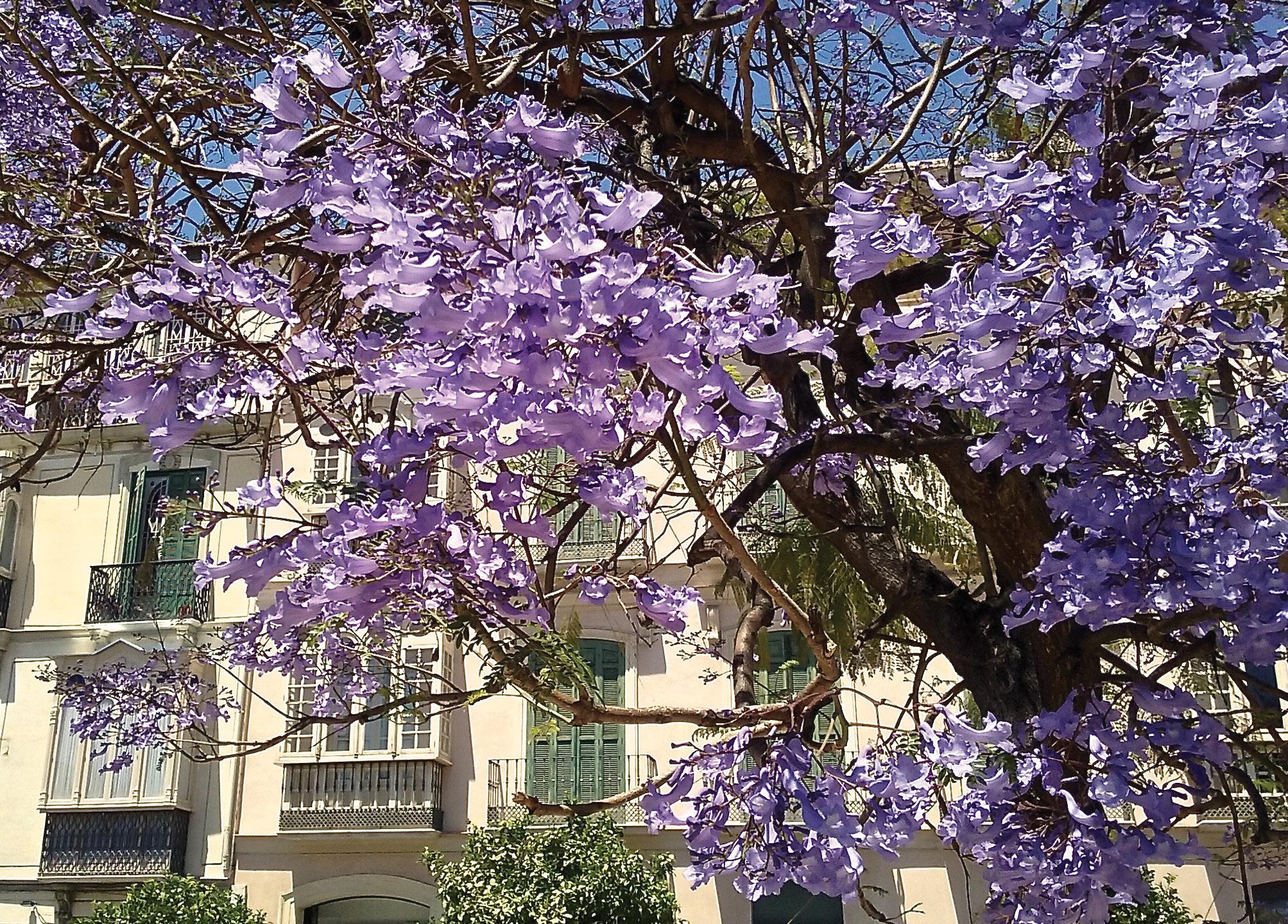
This Friday, we decided to explore some hidden alleys and forgotten corners of the old quarter of Málaga. Though we have been in the city plenty of times, it is still one of our favourite urban jaunts. Often ignored by tourists in favour of the smaller beach towns on the Costa del Sol, Málaga is well worth a day of explorative free-style strolling. Plus, being the museum capital of the Spanish south, there are always fabulous art exhibits with a wide selection of works and styles.
However, this time around, we intend to stay off the beaten track. After all, we are here as escapees, about to enjoy the city’s vicarious pleasures of yet to be known kinds.
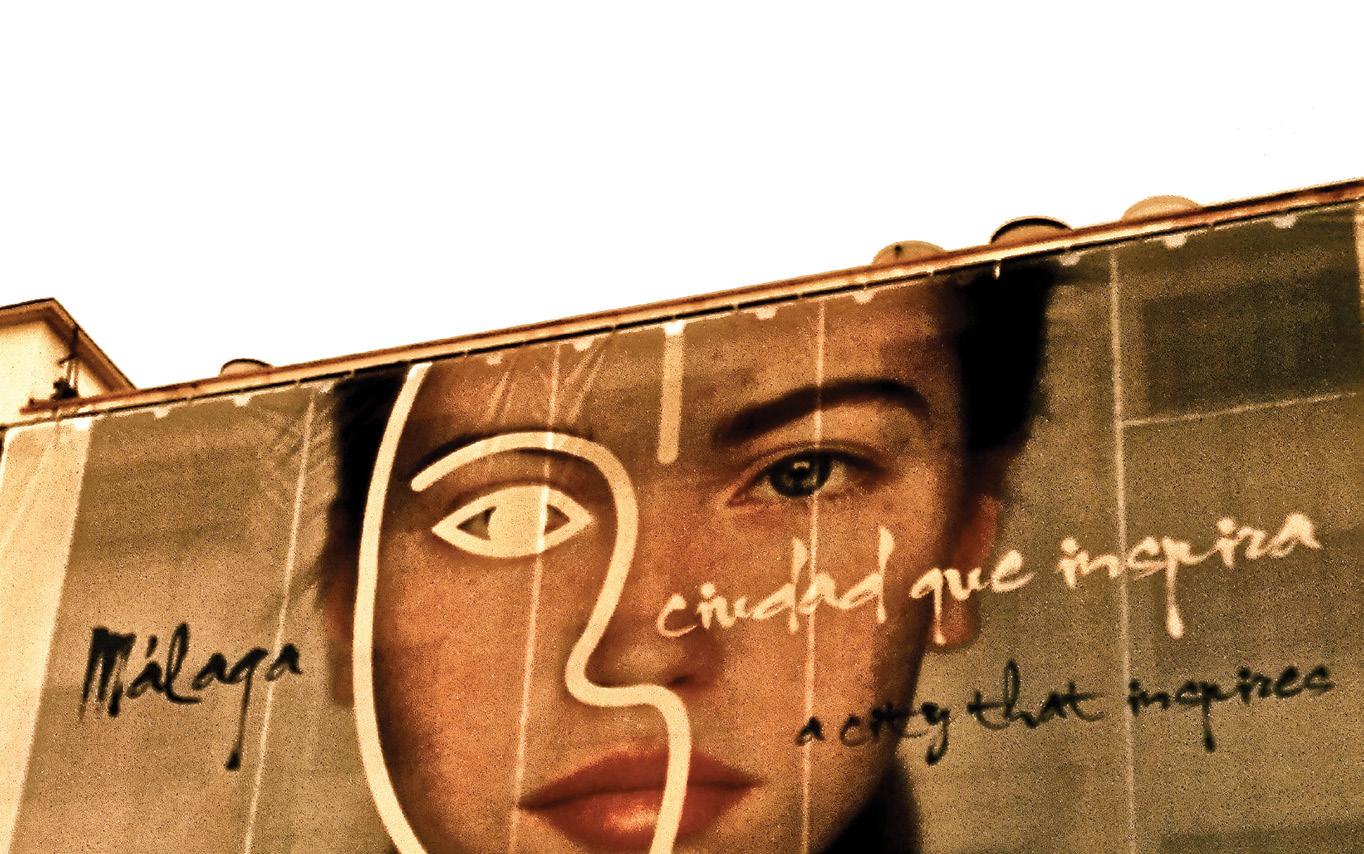
Málaga inspires
For us who live in a quintessential big mountain village, an occasional city spree is a healthy diversion. Málaga isn’t the metropolitan centre of the universe, but with near 600,000 people, it offers us a much-needed urban fix. The city is just the right size to get lost in and to find one’s way again. It has pretty much the right amount of pollution, city dust, shopping variety, ethnic diversity and population density to tempt us by its urban splendour, while reminding us how lucky we are not to partake in its daily traffic jams.
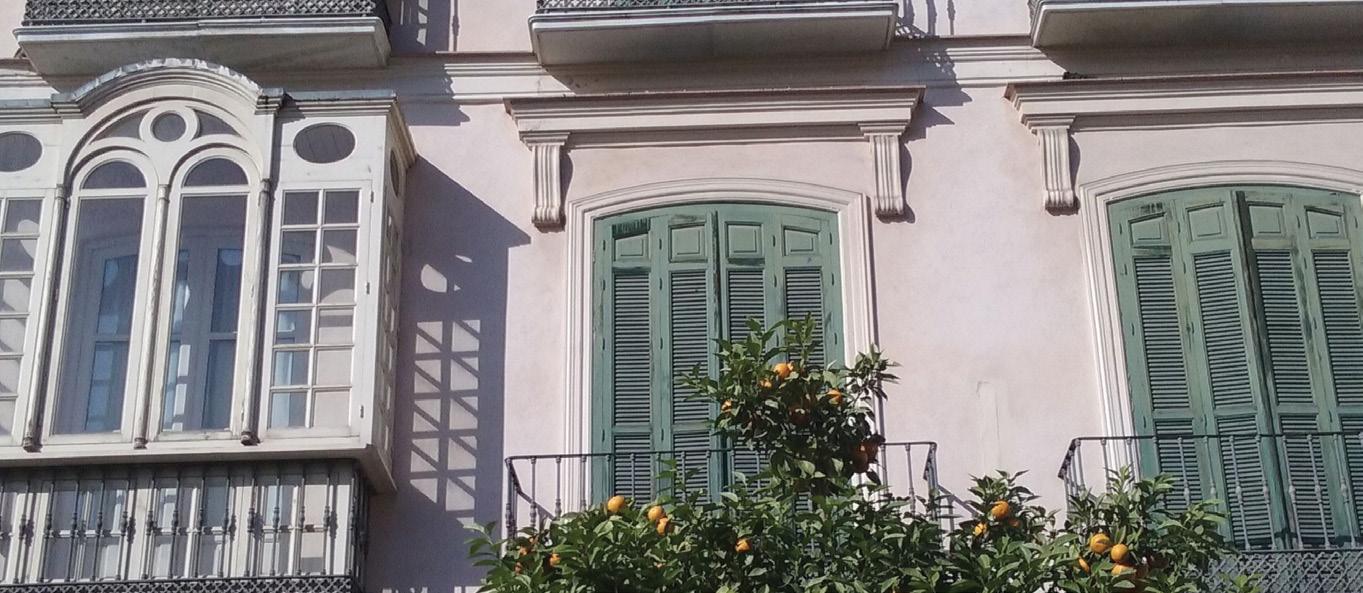
Málaga is only 1.5 hours drive from Ronda, but we decide to leave the car and take a bus instead. Using public transport adds an additional dimension of freedom to our escape, allowing us to enjoy the journey without thoughts of speed traps or parking fines. Getting chauffeured to our destination, and for a modest fee at that, we can be as reckless as we want to, neither of us being the designated driver. Should we loiter about the streets too long, we can always grab a later bus, jump on a train, or find a place to spend the night. Or maybe we just travel on? One doesn’t want to limit one's options too much, does one, or it would not be a true escapade?
BLOOMS ABOUND

After having a shamefully cheap breakfast in a place that boasts about serving eight types of café con leche, all in the same type of glass with varying degrees of milk and espresso, we are ready to roll. Our first stop is a completely unassuming park, Coffee, Málaga style which meanders along one of the main traffic arteries leading into the downtown area. One is guaranteed never to meet tourists here, as who, other than I, will insist on walking blocks on end just to see trees. But, it is worth taking this quick detour, as these particular trees are a sight to behold. While they have trunks covered in cone-shaped lethal spikes, their crown is a delicate filigree of pink blooms.

Tree with spikes
Málaga’s flora is something that always impresses me, being so very different from what one will find merely an hour inland. Wherever you go, there are planters with crimson hibiscus flowers. Even the smallest balconies seem to manage to squeeze in half a dozen pots of geraniums or a trailing bougainvillaea, and the city’s avenues are lined with rows of tall, slender palms.

Look Up
One of my favourite squares here is Plaza de la Merced. You might have passed it on your way to visit the house where Picasso was born, another of the town’s many museums. The neighbourhood is admittedly becoming a bit worn around the edges. The garbage is not emptied as often as it could be and the spray paint artists work faster than the town’s anti-graffiti squad. However, this raunchiness cannot outweigh the almost childlike joy I feel standing in the middle of the square when the jacaranda trees are in bloom and the plaza becomes awash with purple flowers.
POPSICLE COLOURED WALLS

Málaga market, looking towards the old town
Speaking as a designer, the colours of Málaga are one of the city’s true inspirations. Whereas Ronda is one of Andalucía’s Pueblos Blancos or White Villages and therefore stays within a safe all-white colourtheme, Málaga’s architecture is a lively contrast. The beautiful lowrise edifices in the old town can have the most surprising colour combinations. While most remain within the family of warm earth tones, other buildings may combine bold egg yolk yellow with bright

Málaga market
I stop and admire one of these 19-century classics with semicurved walls. This one is facing a smaller plaza. It has six stories of flats, each with a French balcony embellished by art nouveau ironwork. The walls are sand dune coloured, with cool khaki green detailing and cream bisque shutters. It is a combination I would have never thought up. Seen apart, they could almost appear clashing, yet when combined, they look nothing short of spectacular, particularly when augmented by the soft rays of a late afternoon sun.

I walk on in awe, admiring the playful palettes of aubergine, champagne and over-ripe nectarine. Almost enough to make you hungry…
TENTENPIÉ
There is never a wrong time to stop for a tentenpíe, which is the Spanish slang for an appetiser or titbit to hold one off until the next real meal. Often, we stop in Málaga’s lovely old public market for this purpose, but this time we want to escape the line-ups.
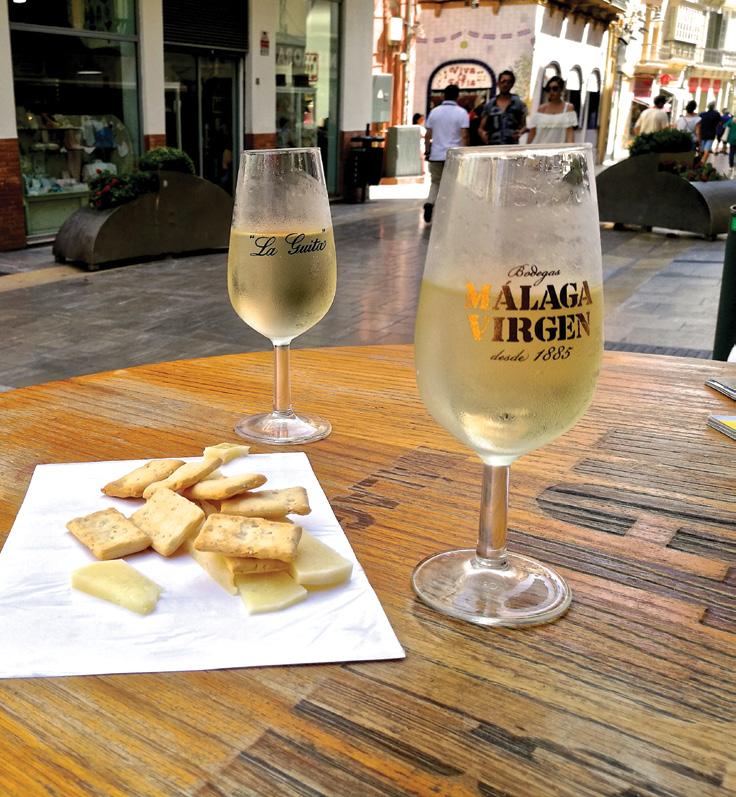
Fino for two
Possibly the best place to enjoy a drink and a couple of appies is in one of the city’s historical almacenes (warehouses). Nowadays, these traditional food vendors are more like a bar combined with a traditional deli. Their escaparates or shop windows, like the shelves inside, are filled with a tempting array of local wines, cheeses, meats, canned seafood, and other malagueñas specialties. It is no better place to meet the locals while getting a taste of real Málaga.

Malagueño wine emerald green or bright pink
We decide to plop ourselves down outside one of the almacenes, enjoying a break, while sipping a frosty glass of local Fino and some wedges of to-diefor oveja (sheep milk) cheese. Hoards of tourists will come home from their Spanish holiday with an abanico (fan) that hardly opens, castanets that will never be used, or an imitation flamenco apron Made in PRC, but how many will drop by one of these delightfully authentic delis and buy some smoked, ground Spanish red pepper to bring home instead?
RIBBONS, BOWLERS AND CHOKERS
In between the dime a dozen chain stores selling cheap shoes and cell phone covers, Málaga still has a few of its traditional family run shops. Some are hidden away in secret alleys, while others can be found squeezed between Italian lingerie emporiums and international frozen yoghurt outlets. Most have discretely faded signs and a dusty window display. But this is where you really can do some authentic shopping. Forget about the Chinese dollarstores that have everything – all poorly made. These stores are the mom and pop kind with over-thecounter service, specialising in one type of item. Their goods are of decent quality and might even be Hecho en España (Made in Spain).

Andalusian-style earrings
One of my favourite examples of these is the traditional Spanish Mercería or Haberdashery. Here, the local housewives will line up to buy 20cm of three different kinds of ribbon. The process of purchase is painstakingly slow since everything has to be brought out from the back room, but it is ever so interesting to observe the tassel-purchasing process from a socio-anthropological point of view.
Next are the traditional ferreterías (hardware stores). To be sure that your chosen location is an authentic one, the wall behind the counter needs to be lined with small drawers. These might contain everything from doorknobs and powdered chemicals, to curious looking rodent-traps and poisons outlawed in 1965.
Equally interesting are the old stores that sell church supplies and religious paraphernalia. This is where you go if, like me, you are tempted to buy one of those silver incense burners suspended from chains that they whiff about during Catholic mass.
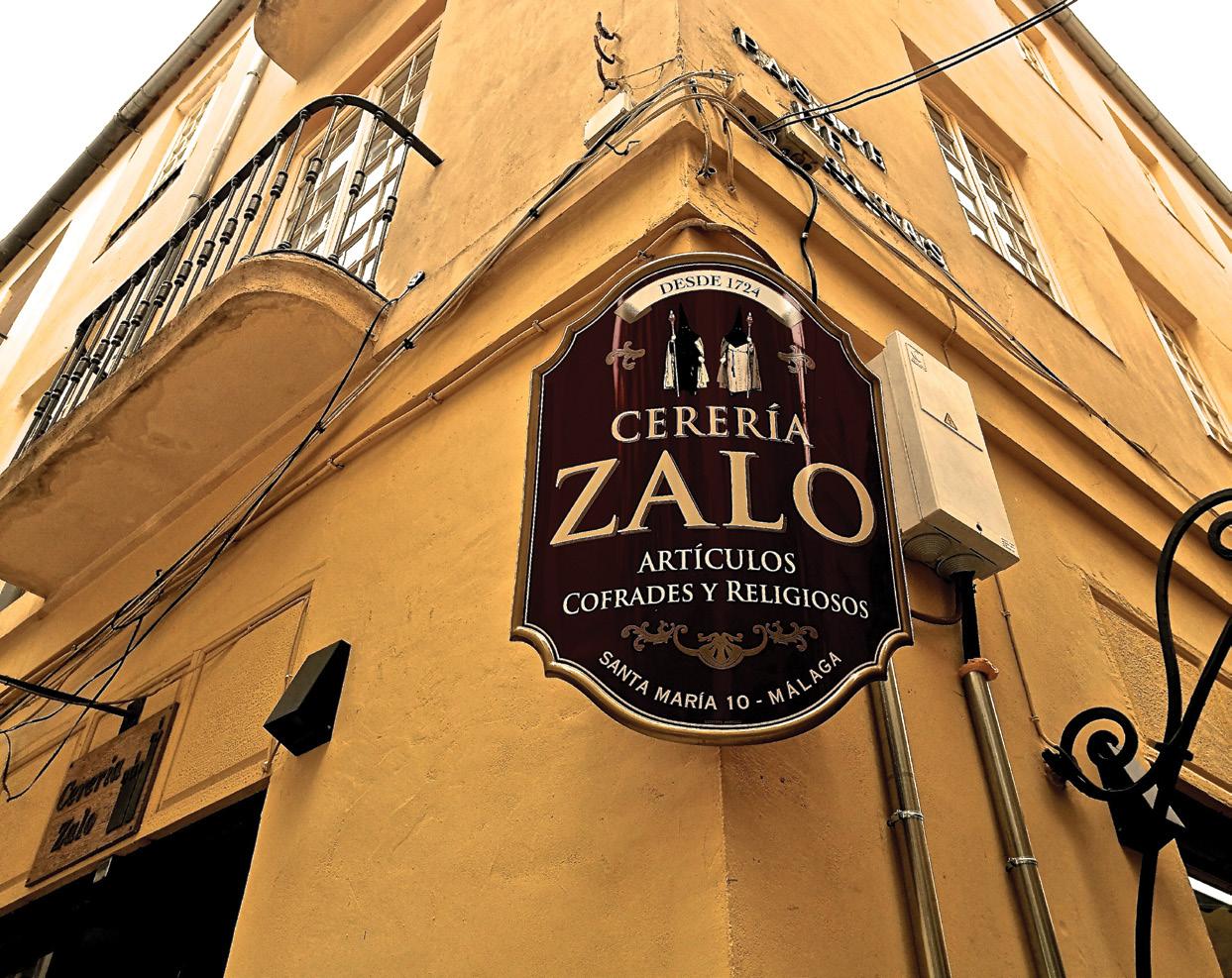
Religious shop sign
As for my husband, he loves the small shops that remind him of visiting his family in Bilbao as a boy. We are talking way back in the last millennium, when Franco was the autocratic ruler. First, there are the little-old-lady owned perfume shops that sell weird brands of splash-on colognes that nobody uses anymore.
Then, there are the traditional linen stores, looking as far from Zara Home as you can imagine. These will usually have a crowded window display with piles of hideous synthetic blankets, practical polysomething tablecloths and a selection of could be handmade doilies and baby bibs. Though we have never bought anything in the latter type of store, they are always cool to peak into. The prices are also a hoot, as I once noted childrens' cotton undershirts for €1,70 and baby shoes for a whooping €2,30.
Like most large Spanish cities, Málaga also has a couple of the traditional hat stores, where they will still measure your head and display hats on wooden cranium-shaped domes. The owners of these businesses tend to be far beyond retirement age, so it is wise not to wait too long to visit these premises, or they might have closed down. Here is where you will find a Fedora, a genuine Panama hat, or (not by the store owner’s intention) brand new, yet now vintage hats for any festive occasion.

Manila shawl detail
I also enjoy visiting a Flamenco store. I am not speaking about the souvenir shops that sell poor ruffled imitation dresses. This is the real thing, where they design and sew the colourful flamenco gowns from scratch and where you can find a genuine Manton or Manila shawl for several hundred euros. I love their ever so stylish Flamenco leather shoes, though I cannot for the life of me dance the Sevillana. But their outrageously huge loped Flamenco earrings are another matter...
REFUELLING
Being quite shopped out, though we hardly have bought anything, it is time for some grub, of which Málaga has got aplenty. The old town is usually crawling with tourists, but you can still find decent restaurants with mostly local clientele, merely a couple of blocks off the main drag. Wherever you go, it is advisable to avoid places that hand you a voucher as you pass by, as well as those who offer a €10 daily plasticised menu written in seven languages with pictures of their sad excuse for a paella and canned rabo de toro.
Though we usually go for ethnic food when in the big city, this time we decide on a new organic place. Located on a corner in a residential street, we appear to be the only out-oftowners. I am certainly the only non-Latina.

Restaurant in old town Málaga
From our street-side table, we are able to do some quality people watching, as the real malagueños – fashionable, traditional, risqué or retro punk – go about their daily lives. Business people bike back from work (some female lawyers with 8 cm heels), parents pick up the kids from preschool, workers deliver cases of wine and neighbours chat from one window to the next. During another escapade here, we got to watch aspiring ‘actors’ and ‘actresses’ enter the casting session for what appeared to be a not completely legit adult movie. This time around, we are just as lucky, catching a band practice in a building across the street. Though we do not see the musicians, we get a free Spanish guitar concert, and this, just a handful blocks from Calle Larios, Málaga’s busiest walking mall.

LOOK UP, LOOK DOWN
I should mention that this very same pedestrian-only avenue, which crosses the Casco Histórico, has the most beautiful rust coloured marble paving (for those who manage to tear their eyes away from the wallto-wall shopping bonanza). Each piece of marble is so remarkable that I would take any of them home and put it as art on the wall. The stone looks particularly stunning when it has been recently polished, around Semana Santa and before Christmas. They also look great after a downpour, though water makes the stone lethally slippery, so consider yourself forewarned.

A real dog fountain!
Actually, this is yet another great thing about escaping to a place where we usually do not trot daily. We tend to look up more, or down as in the case of the pavement. At home, walking the same old streets, I often forget to see what really surrounds us. During an escapade, on the other hand, my head continually swivels, enjoying both horizontal and vertical splendours. Escaping allows one to see life from a slightly different angle, inspiring one to observe and sense more intensely, even as one returns to familiar surroundings.
The evening has come upon us. Though there is still much urban exploring to be done, such as enjoying the sunset from Málaga’s Cathedral roof or watching a foreign movie in its original language. But we feel more than content. Filled with new sights, sounds and tastes, we wander back to the bus station, where the same driver chauffeurs us home. As I watch the beautiful sculptural landscape of Andalucía flying by, I know that we will escape again a Friday or two from now. But where we will go is yet to be decided.
About the writer: Karethe Linaae is a Norwegian writer and author living in Ronda, Andalucía. Her book, Casita 26 – Searching for a Slice of Andalusian Paradise was published in the USA in 2019. For more information, please go to snobb.net
#issuuloves #issuu










